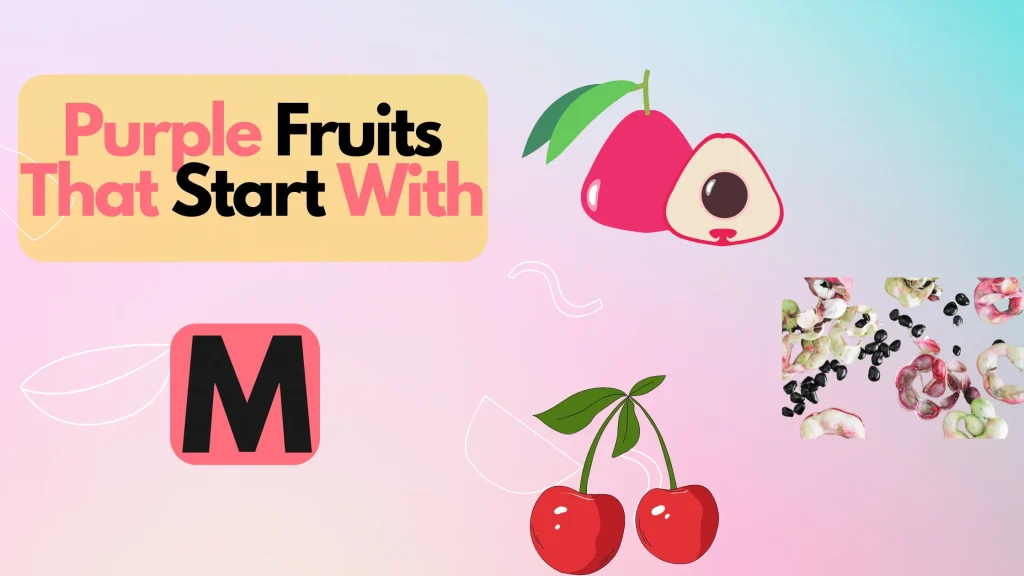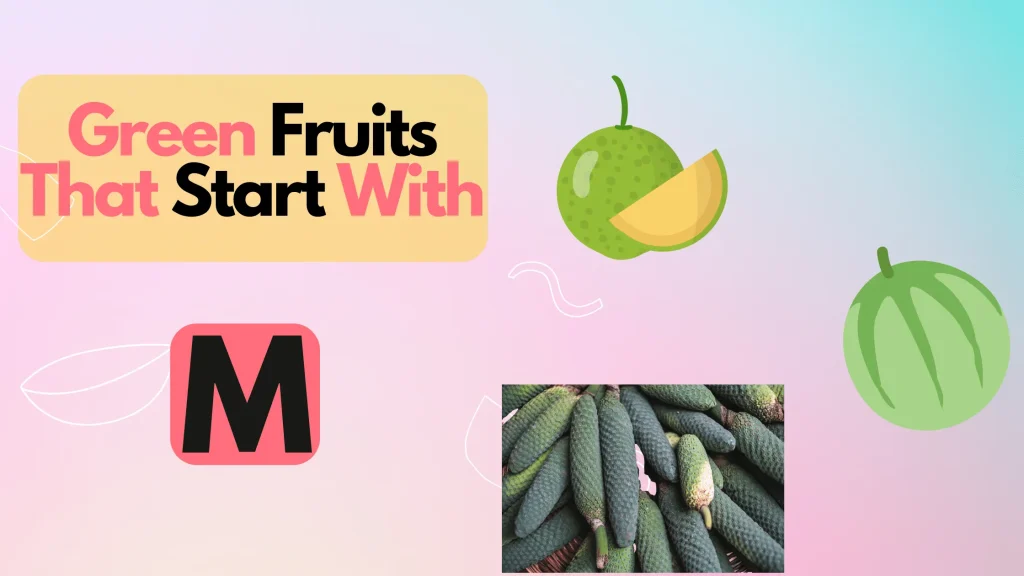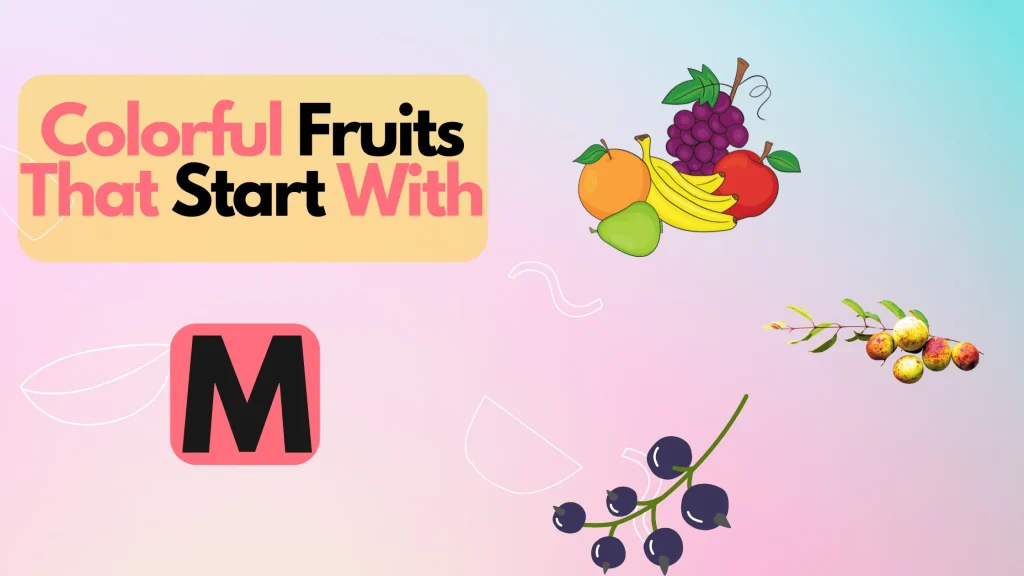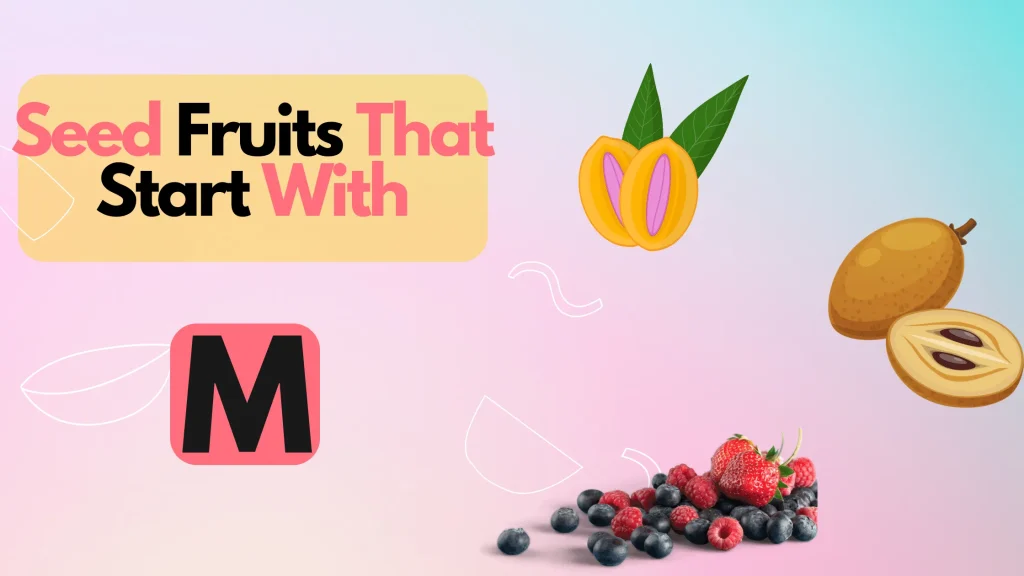If you’re looking for a delicious fruit that starts with the letter M, you’re in luck! There are plenty of options to choose from. For example, you could go with a classic like an apple or banana, or try something new like mango or passionfruit. No matter what your preference is, there’s sure to be a fruit that starts with M that will satisfy your taste buds.
Red Fruits That Start With M:
Mandarin Fruits:
Mandarin fruits are very nutritious and contain a variety of vitamins, minerals, and other substances that are beneficial for human health. All of these substances have been linked with various health benefits. Dietary fiber helps to regulate digestion, polyphenols have antioxidant properties, vitamin C helps to boost the immune system and beta-carotene can be converted into vitamin A which is important for maintaining healthy skin and vision.
Marionberry:
Marionberry is a cross between two blackberries, the Chehalem and the Olallie. The Marionberry was developed in Oregon and is now the most popular blackberry grown in the United States. It has a sweet-tart flavor and is used for both fresh eating and for making jams, pies, and other desserts.
Miracle Fruit:
Miracle fruit (Synsepalum dulcificum) is a small, red, sweet fruit that has the ability to make sour foods taste sweet. The active ingredient in miracle fruit is called miraculin. Miraculin binds to sweet receptors on the tongue and alters the way they interpret sour flavors. Miracle fruit first came to prominence in the early 1970s when it was used as a treatment for people with diabetes who could not tolerate the sour flavors of certain foods. Today, miracle fruit is mostly used as a novelty food or as
Mock Strawberry:
A mock strawberry is a fruit that has been genetically engineered to have the same flavor and consistency as a strawberry.
The mock strawberry was created by scientists at the Plant Research International institute in the Netherlands. They used a gene from a tomato to create the fruit, which is why it has such a similar flavor to strawberries. The scientists were able to do this by deleting two genes in the tomato plant that are responsible for the production of certain aroma compounds.
Mayhaw:
Mayhaw is a small, tart fruit that grows in the Southeastern United States. It’s used to make jellies, jams, and other preserves. Mayhaw jelly is a popular item in the region, and it can be found in grocery stores and farmers’ markets. The fruit is typically harvested in late April or early May. It’s a tough fruit to pick because it’s so small, but most people seem to like the challenge. The berries are ripe when they turn a deep red color.
Melinjo Fruit:
Melinjo fruit is a tropical fruit that is often enjoyed in Indonesia. The fruit has a sour and acidic taste and is used as a spice in many Indonesian dishes.
The fruit is also high in protein and vitamin C, making it a healthy choice for those looking for a nutritious snack. Melinjo fruit can be eaten fresh or cooked and is the perfect addition to any meal.
Moriche Palm Fruit:
The moriche palm fruit is a delicious and nutritious addition to any diet. It is rich in vitamins A, C, and E, as well as potassium, zinc, and magnesium. It also contains significant levels of fiber and antioxidants, which make it an excellent choice for boosting overall health. Additionally, the moriche palm fruit has a sweet, fruity taste that most people enjoy.
Purple Fruits That Start With Letter M:

Malay Apple:
The Malay apple ( Syzygium malaccense ) is a rainforest tree in the Myrtaceae family. The fruit of this tree is frequently eaten by animals such as monkeys, and also humans. It has a sweet and sour taste and is high in Vitamin C.
The Malay apple tree is an evergreen that can grow up to 60 feet tall. The leaves are elliptical, and the flowers are white with 5 petals. The fruit is about 1 inch wide and has red skin with white flesh. It tastes like a cross between a lemon and an apple and is high in Vitamin C.
Manila Tamarind:
The Manila tamarind (Tamarindus indica) is a leguminous tree in the family Fabaceae. It is found throughout Southeast Asia and parts of East Asia.
The fruit of the Manila tamarind is edible and has a sour taste. It is used as a souring agent in Philippine cuisine. In Indonesia, the fruit is called Asam manis and is used in traditional dishes such as Soto Ayam and gudeg.
Muscadine Fruit:
Muscadine fruit is a dark purple grape that is native to the Southeastern United States. The skin and seeds of muscadine grapes are thick and tough, so they are typically eaten after being peeled or removed from the seeds.
Muscadine grapes are a good source of antioxidants, including resveratrol. They also contain high levels of vitamin C, fiber, and ellagic acid. Ellagic acid is thought to play a role in cancer prevention.
Mangosteen:
The mangosteen is a tropical fruit that is said to have many health benefits. Some people also believe that mangosteen can help with weight loss and anti-aging.
There is limited scientific evidence to support these claims, but the fruit does contain nutrients like vitamin C, potassium, and fiber. Additionally, mangosteen has a high antioxidant content, which can help protect cells from damage. So while there is no definitive proof that mangosteen offers any special health benefits, it’s certainly a nutritious fruit worth considering adding to your diet.
Mora De Castilla:
Mora de Castilla is a blackberry-flavored liqueur made in the Spanish province of Toledo. It is composed of sugar, alcohol, and blackberry extract.
Mora de Castilla has a sweet, fruity taste that makes it a popular addition to cocktails and coffee drinks. It can also be enjoyed on the rocks or used to make delicious desserts.
Merlot Grape:
The Merlot grape is a dark-skinned grape used to make red wine. It is the most widely planted grape in the world and is particularly popular in France and Italy. The flavor of Merlot wines depends on the climate and terroir where the grapes are grown, but they are typically fruity with notes of black cherry, blackberry, and raspberry. Some winemakers also add touches of chocolate or oak for complexity.
Green Fruits That Start With Letter M:

Mamoncillo:
Mamoncillo is a tropical fruit that tastes a bit like mango, with a sour and acidic aftertaste. It’s often eaten as a dessert or snack, and can also be used to make juices, smoothies, or cocktails.
Some people find mamoncillo unpleasant to eat because of its sour taste, while others enjoy its unique flavor. If you’ve never tried it before, it might be worth giving it a try to see if you like it!
Melon Pear:
There are all sorts of melon pear hybrids, some of which are more popular than others. The trick is to find a variety that is suited to your climate and growing conditions.
The best way to find out which types of melon pears are best suited for your region is to do a little research online or ask your local gardening expert. There are also lots of great books on the subject, so if you’re serious about starting a home garden, I highly recommend checking out your local library or bookstore.
Monstera Deliciosa Fruit:
The Monstera deliciosa fruit is a tropical fruit that is often eaten as a snack or used in desserts. It has a sweet taste and is full of nutrients, including vitamins A and C, potassium, and magnesium.
The fruit is also high in fiber, which can help to regulate digestion. Additionally, the antioxidants present in the fruit can help to protect the body against free radicals and oxidative stress. Overall, the Monstera deliciosa fruit is a healthy snack choice that provides a variety of nutrients essential for good health.
Colorful Fruits That Start With The Letter M:

Madrono Fruit:
The madrono fruit is a sweet and sour berry that is found in the tropical regions of Central America and South America. The fruit is small and red, with a tart flavor that is similar to cranberries.
Madrono fruit is a good source of Vitamin C and antioxidants, which can help to protect the body against disease. The fruit also contains dietary fiber, which can help to regulate digestion. Madrono fruit is most commonly eaten fresh, but can also be used in jams, jellies, or juices.
Mangaba Fruit:
The madrono fruit is a sweet and sour berry that is found in the tropical regions of Central America and South America. The fruit is small and red, with a tart flavor that is similar to cranberries.
Madrono fruit is a good source of Vitamin C and antioxidants, which can help to protect the body against disease. The fruit also contains dietary fiber, which can help to regulate digestion. Madrono fruit is most commonly eaten fresh, but can also be used in jams, jellies, or juices.
Maqui:
The Maqui berry is an antioxidant-rich fruit that is native to Chile and Argentina. It has been used for centuries by the indigenous people of those countries to treat a variety of ailments, including sore throats, indigestion, and arthritis. Maqui berries are also high in anthocyanins, which are antioxidants that have been shown to have anti-inflammatory and anti-cancer properties.
There is some research that suggests that the maqui berry may help improve blood sugar control and lower cholesterol levels, but more research is needed to
Marula Fruit:
The marula fruit is a small, yellowish-green fruit that is found in the savannas of southern Africa. The fruit has a sweet and sour taste, and is often eaten fresh or used to make jams, jellies, and juices.
The marula tree provides an important source of food and shelter for both people and animals in southern Africa. The kernel of the marula fruit is high in oil, proteins, and minerals, making it a valuable source of nutrition for both people and animals. Marula oil is also used in cosmetics and skincare products.
Dry Fruits That Start With M:

Macadamia:
Macadamia nuts are a great source of healthy fats and are known for their buttery, creamy taste. They’re also one of the most expensive nuts on the market.
Macadamia nuts are a good source of thiamin, niacin, and vitamin B6. They’re also a good source of minerals such as magnesium, potassium, and zinc. Magnesium is important for energy production and nerve function, potassium helps to regulate blood pressure, and zinc is necessary for optimal immune function.
Mammee Apple:
The Mammee apple (Mammea americana) is a tropical fruit tree species in the family Caryophyllaceae. It is the only species in the genus Mammea.
The fruit has a sweet and sour taste, and is eaten raw or made into juices, jams, and jellies. In many parts of the world, it is also used to make wine. The latex from the tree bark is used to make rope, paper, and caulking material for boats, and can also be turned into drinking cups or bowls.
Marang Fruit:
The marang fruit (Artocarpus integer) is a tropical fruit that is related to the jackfruit. It is popular in Southeast Asia, where it is known as the “breadfruit”.
The marang fruit is high in dietary fiber, vitamin C, and minerals such as potassium. It has a sweet and tangy taste and can be eaten fresh or used in jams, jellies, and other recipes.
Mayan Nut:
The Mayans were a group of Native American peoples who inhabited parts of Mexico and Central America before and during the time of the Spanish conquest.
Mayan cuisine was based on maize (corn), beans, and chili peppers. They also cultivated fruits, vegetables, and herbs. Some typical dishes include tamales wrapped in corn husks, quesadillas filled with cheese or squash blossoms, and a type of pumpkin seed brittle called xocoatl.
Mountain Pepper:
Mountain pepper (Tasmannia lanceolata) is a type of pepper that is native to Tasmania, Australia. The fruit of the plant is used to make a hot sauce that is said to have a unique flavor.
Some people say that the taste of mountain pepper reminds them of black pepper, while others say that it has a unique flavor all its own. The sauce made from the fruit of the mountain pepper plant is said to be good for increasing appetite and preventing digestive problems.
Macoun Apple:
The Macoun apple is a cross between a McIntosh and a Jerseymac apple. It has a sweet-tart taste and is firm, but not as hard as Granny Smith apples. It is good for eating fresh, in salads, or cooked in pies and sauces.
The Macoun apple was developed at the New York State Agricultural Experiment Station in Geneva, New York, in the early 1920s by Reverend John A. Macoun.
Seed Fruits That Start With M:

Maprang:
Maprang is a sour fruit that is green when unripe and turns orange when ripe. It is the size of a lime and has a bumpy exterior. The flesh is segmented like an orange, and the segments are filled with small seeds. The taste is sour and acidic.
Maprang grows in tropical climates and can be found in Southeast Asia, India, Sri Lanka, and parts of Africa. It is most commonly eaten as a fruit snack or used in cooking to add a tart flavor to dishes.
Mamey Sapote:
The mamey sapote (Pouteria sapota) is a fruit tree native to Mexico and Central America. The fruit is brown or reddish-brown, with a firm texture and a sweet flavor reminiscent of pumpkin, sweet potato, or apricot.
The mamey sapote is commonly eaten raw, but can also be used in smoothies, juices, milkshakes, cakes, and cookies. It is high in vitamins A and C, calcium, magnesium, and potassium.
Midyim Berries:
Midyim berries are tart, dark red berry that grows on a small bush. They are typically about the size of a blueberry and have smooth skin. Midyim berries are found in the rainforest of Northern Queensland, Australia. The Midyim Berry Aboriginal Corporation is working to bring this delicious fruit to the world market.
Midyim berries are high in antioxidants, vitamin C, and dietary fiber. They also contain anthocyanins – plant pigments that give fruits and vegetables their color.
Morinda:
Morinda is a plant that grows in the Pacific Islands and is used to make a drink called “tamarind”. Tamarind is a popular drink in the South Pacific and Southeast Asia. It is made from the extract of the fruit of the Morinda citrifolia tree.
The juice contains dozens of biologically active compounds, including alkaloids, flavonoids, terpenes, and anthraquinones. It has traditionally been used to treat a wide variety of health problems, including malaria, constipation, fever, pain relief, reducing swelling (inflammation), and as a general tonic. Some people also use it as an aphrodisiac.
Mango:
Mangoes are a delicious fruit enjoyed by many. They’re high in antioxidants and vitamin C and offer numerous health benefits. Here are some of the top reasons to include mangoes in your diet:
Mangoes contain a compound called mangiferin, which has been shown to have anti-inflammatory and antioxidant properties.
Mangoes are a good source of dietary fiber, which can help with weight loss and digestive problems like constipation.
Mangoes are a source of beta-carotene, which the body converts into vitamin A. Vitamin A is important for maintaining healthy skin, hair, and eyesight.
Source: GoodlyRecipes.com






